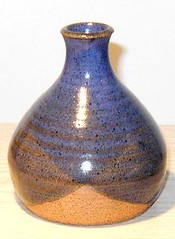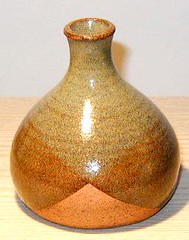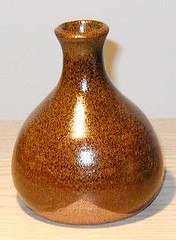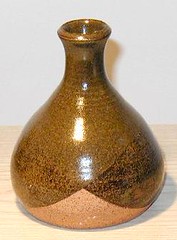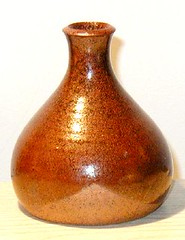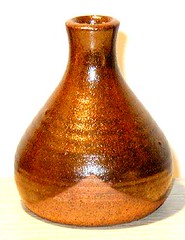Transcript from The Times of September 13, 2003
Reinventing the wheel
David Sexton interviews Edmund De Waal, celebrity potter
An intelligent potter is a rare bird, like a flying fish. Not impossible, not unheard of, just not often seen. We have one at the moment, though. In the past few years, Edmund de Waal has begun to exert an extraordinary influence on the world of studio ceramics, both through his own pots and as a writer and lecturer. In a quiet but resolute way, he has begun to reshape our sense of the history of modern ceramics and the possibilities of the form.
De Waal’s own pots — bowls, bottles, beakers, dishes and jars, thrown in porcelain, glazed in celadon, squeezed and dented, assembled in series — have brought him extraordinary success since his first solo show in 1995. They quickly became ludicrously fashionable.
The fashion designer Donna Karan snapped up an entire exhibition of 70 pots. Issey Miyake is a fan. At the height of the minimalist fad a few years ago, his work was in almost every issue of every decorating magazine.
“You’re lucky if you’re part of the Zeitgeist,” de Waal acknowledges. “But you know that’s going to go, you know that you can’t make your life and career on those three years when you’re in House & Garden every month.”
De Waal is delighted to have met some of the luminaries who buy his work: Shirin Guild — he is wearing one of her sky-blue, collarless linen shirts — and the pianist Mitsuko Uchida. “I’m thrilled that she likes my pots. Less thrilled about Donna Karan,” he says. De Waal is reserved and gentle, but he also has a habit of saying what he thinks. He is modest but not falsely so. He knows what he’s about.
We meet in his studio, in a side street of light industrial units off Peckham Road — a big, airy, whitewashed space, shared with several apprentices and another potter, Julian Stair. At one end is another kind of workroom, an office-cum-library-cum-gallery. On a single long shelf at waist height, works in progress are lined up for consideration.
On the other side of the room are shelves full of books on art, architecture and literature, as well as on ceramics. A glass display case shows a few of his pieces, while another, a large cylindrical shape that might sell for a thousand or two, serves as a wastepaper basket. Ella, his big, friendly Italian hunting dog, with mournful eyes and sloppy chops, wanders in and out.
De Waal is tall and thin, extremely neat, altogether spare and contained. In the one good book on pottery aesthetics, Ceramics, Philip Rawson muses on they way that pots reveal not only the potter’s craft — “the reality of materials and process” — but also his sense of himself in the world. Are De Waal’s pots idealised projections of himself?
“Yes, I do that,” he replies. Then, after pausing, he says: “You feel that you can begin again every day and make yourself anew. Before you make a pot in the morning, and you start wedging the clay, you feel that this is day one — and you sit down and you start to make, and you are completely aware of your body, and your ideas, your head is full of possibilities. You never ever get there — and that’s fantastic.”
What would his pots say about him? “My fantasy is that people will look at my pots and think: rigorous, yet quite passionate and humane.” As anybody who lives with them knows, they embody such paradoxes — highly finished and yet apparently still provisional, almost malleable with indentations and squeezings. They are domestic and practical but also exist in another realm — the numinous, the sacramental — particularly when grouped together; somehow restrained and voluptuous.
De Waal comes from an intellectual Anglican family. His father, Victor, now retired, was dean at Canterbury; his mother, Esther, writes devotional books on the rule of St Benedict and other meditative subjects. De Waal’s wife, Sue Chandler, with whom he has two boys and a girl, is similarly high-minded, working in international development agencies.
At King’s School, Canterbury, de Waal was taught pottery by Geoffrey Whiting, an austere disciple of Bernard Leach. Leach, the mystical father of the British studio pottery movement, has mattered a great deal to de Waal.
He has done more than anybody else to dismantle Leach’s mystique, notably in a critical short biography — and yet he has also come closer to making real Leach’s dream of a genuinely Anglo-oriental pottery than any of Leach’s more complacent followers.
After taking A levels early, de Waal apprenticed himself to Whiting for two years. Although he has now rejected the ware he learnt to make in the St Ives style — tenmoku-glazed stoneware, imitations of St Ives “standard ware”, and so forth — he remains appreciative of the training he received and devoted to Whiting’s memory as a man.
“The complete rejection of everything that your teacher teaches you is a good and necessary thing. I’ve no problem with patricide or parricide. I would regard myself as a failed teacher if the people who’ve worked for me are making beautiful celadon pots in ten years’ time.”
De Waal went on to read English at Cambridge and took a first, but remained committed to making pots. To equip himself further, he studied Japanese at Sheffield University and then, in the early Nineties, went on a scholarship to live in Japan. There he spent his mornings researching Leach’s activities and his afternoons throwing pots. In contrast, Whiting based his pottery on Japanese influences but never visited the country.
De Waal’s study of Leach, published in 1998, infuriated many potters. It showed how limited Leach’s real knowledge of Japan was (he never learnt to read Japanese), how romanticised and patronising his orientalism was — and how much he had relied upon skilled assistants to overcome his weakness at throwing.
Although still in his thirties, de Waal now finds his own pots widely and shallowly imitated. It’s possible to walk into a mixed exhibition or look at a page of magazine and see his influence everywhere without seeing a single piece of his own work. It used to worry him. Not any more.
“Basically, they’re crap,” he says, laughing, “partly because it’s about adopting a style without thinking it through. Using porcelain in a gestural way and deploying a palette of celadon glazes which weren’t being used ten years ago came through very hard work — looking at pots in Japan, Korea and China, and thinking hard about how to make pots that worked for the hand. Most of the copies seem just to be about being pale.”
In October, de Waal will publish a new book, 20th-Century Ceramics, in the Thames & Hudson World of Art series. It is an entirely new and surprising history, taking in whole areas that will be unfamiliar to those brought up on the folkcraft version, from Gauguin and the Russian Revolution to Italian Futurism. Picasso, Miro, Fontana and Noguchi figure as large as Leach, and there is much about the architectural context of ceramics, too. “Contexts do change,” de Waal concludes. “Like the other arts, ceramics have the power to move, placate, anger and inspire.”
As he talks, de Waal reaches out to a recently made “cargo” dish on a shelf, rubbing the lip where the glaze has been removed to expose the body — he has been experimenting with white stoneware. All of his attention is directed here, to the subtle differences in balance, symmetry, texture.
“The bottom line is that I want to make things that are so beautiful that people have a strong and bodily experience when they see or handle them,” de Waal says.
His intent is so serious that he can’t bear living with his work decoratively at home. “I can’t be doing with that. I look at them, they bug the hell out of me. There, that’s a real hostage to fortune, isn’t it?”
Edmund de Waal solo exhibition, Contemporary Applied Arts, 2 Percy Street, London W1; Sept 19 to Nov 1. His book, 20th-Century Ceramics, will be published by Thames & Hudson next month.
David Sexton is literary editor of the London Evening Standard

